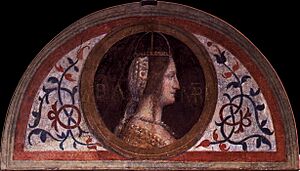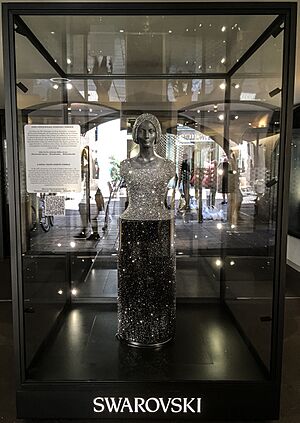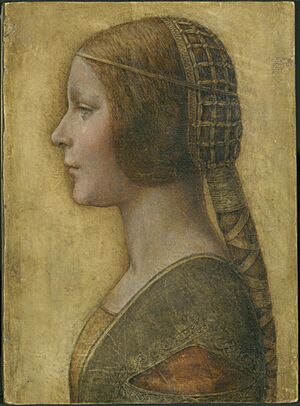Bianca Maria Sforza facts for kids
Quick facts for kids Bianca Maria Sforza |
|
|---|---|

Portrait by Bernhard Strigel, ca. 1505/1510
|
|
| Holy Roman Empress | |
| Tenure | 4 February 1508 – 31 December 1510 |
| Queen of the Romans Archduchess consort of Austria |
|
| Tenure | 16 March 1494 – 31 December 1510 |
| Duchess consort of Savoy | |
| Tenure | 6 January 1474 – 22 September 1482 |
| Born | 5 April 1472 Pavia |
| Died | 31 December 1510 (aged 38) Innsbruck |
| Burial | Stams |
| Spouse |
|
| House | Sforza |
| Father | Galeazzo Maria Sforza |
| Mother | Bona of Savoy |
Bianca Maria Sforza (born April 5, 1472 – died December 31, 1510) was an important royal figure in European history. She became the Queen of Germany and later the Empress of the Holy Roman Empire. She was the third wife of Maximilian I. Bianca was the oldest daughter of Duke Galeazzo Maria Sforza of Milan and his second wife, Bona of Savoy.
Contents
Early Life and First Marriage
Bianca was born in Pavia, Italy. Her father was Duke Galeazzo Maria Sforza of Milan. She was named after her grandmother, Bianca Maria Visconti. When Bianca was almost five years old, her father was sadly killed in Milan in December 1476.
When she was only 21 months old, Bianca was promised in marriage to her cousin, Duke Philibert I of Savoy. He was the son of her uncle, Amadeus IX of Savoy. Duke Philibert I died in 1482, which meant Bianca became a widow at just ten years old. She then returned to Milan. Her uncle, Ludovico Il Moro, looked after her. He let her follow her own interests, like needlework, instead of focusing on her education.
Later, in 1485, Bianca was engaged to John Corvinus. He was the only son of King Matthias Corvinus of Hungary. The Hungarian king hoped this marriage would help his son inherit Hungary and Bohemia. A marriage agreement was signed in 1487, and Bianca was promised several Hungarian regions. However, the marriage never happened because of opposition from Queen Beatrix, King Matthias's wife. In 1492, there was also talk of Bianca marrying King James IV of Scotland, but this idea was quickly dropped.
Queen and Empress
On March 16, 1494, Bianca married her second husband, King Maximilian I of Germany. Their wedding took place in Hall, Tyrol. Bianca's uncle arranged this marriage. He wanted Maximilian to officially recognize him as a duke. In return, Maximilian received a very large dowry (money or property brought by a bride to her husband). Bianca's wedding procession was very grand and attracted a lot of attention. She wore a special dress with many jewels.
Their marriage was not a happy one. Maximilian felt that Bianca was not as wise as his first wife. He thought she was not educated enough, talked too much, and spent money carelessly. Bianca liked her stepchildren, Philip and Margaret. However, some people said she acted like a child and forgot her important position as Maximilian's wife.
Bianca did not have any children with Maximilian. This was a problem because having heirs was very important for royal families. Maximilian focused on the children from his first marriage for succession. After 1500, Maximilian lost interest in Bianca. She lived with her own court in different castles in Tyrol.
In 1508, Maximilian took the title of emperor-elect of the Holy Roman Empire. This made Bianca the Empress. Even though their marriage was difficult, Maximilian did support her rights in some cases. He also sent her letters, even if they were not always comforting.
Empress Bianca died in Innsbruck on December 31, 1510. She was buried in Stams. Maximilian did not attend her funeral or even put a gravestone for her. His court did wear black to remember her.
Life at Court
Bianca had her own court with about 150 to 200 people. She was known for being extravagant. However, Maximilian did not let her control her own money. This meant her court sometimes lived in luxury and other times faced poverty.
Church festivals were very important at Bianca's court. Easter, Christmas, Pentecost, and Corpus Christi were celebrated grandly. Her court also enjoyed carnivals, dances, tournaments, music, and hunting. These activities were a big part of her daily life as queen and empress.
In 1503, Bianca was convinced by a woman named Anna Laminit from Augsburg. Anna claimed to be a "hunger saint" and tricked many people, including Maximilian. Bianca led a special procession with city officials because of Anna's influence. Later, Maximilian's sister, Kunigunde, exposed Anna Laminit as a fraud. Anna was eventually expelled from Augsburg.
Bianca also attended public events in Freiburg. In 1498, she reviewed troops with Maximilian. She also helped with the funeral of a nobleman named Veit von Wolkenstein.
Modern Views on Bianca Maria Sforza
Historians today have a more interesting view of Bianca Maria Sforza. For a long time, people thought she was not as important as Maximilian's first wife, Maria of Burgundy. However, new research shows that Bianca was an educated woman. She played a role in politics, acting as a go-between for her uncle Ludovico and Maximilian.
Some historians believe that Bianca influenced Maximilian's administrative reforms in Austria and Germany. They suggest that after her marriage in 1494, these reforms started to be shaped by the Milanese way of doing things, rather than just the Burgundian way. Bianca helped to balance these influences.
After Bianca's death in 1510, building projects for Maximilian's imperial home in Innsbruck stopped completely. This suggests that these projects were connected to their marriage.
Bianca Maria in Arts and Media
- The Wedding Hours made for Bianca Maria Sforza and Maximilian I was a wedding gift from her uncle. This artwork shows the high level of art during the Renaissance. It also shows how art was used to connect social, religious, and political life.
- La Bella Principessa is a famous portrait. Some experts believe it is a painting of Bianca Maria by Leonardo da Vinci.
- In 1993, new statues were made for the Kaiserbrunnen fountain in Konstanz. Bianca Maria's statue was added. Maximilian's statue is shown reaching out his hand, and a bird on Bianca's hat sometimes spits water into it. This is a playful way to show their marriage was based on money and that Maximilian always had financial problems.
- Bianca Maria is the main character in a 2019 musical called Schattenkaiserin (The Shadow Empress). The musical shows Bianca as a sad character. Maximilian is shown as a cold husband who married her for money and then left her to focus on wars and other things.
- In 2019, the jewelry company Swarovski made a copy of Bianca's lost wedding jewelry. It is shown on a bust (a sculpture of her head and shoulders) created by artist Tibor Bogdan.
Commemoration
Bianca Maria Sforza is remembered in various folk festivals in South Germany and Austria. These festivals are often held in cities she visited during her lifetime. People often dress up as Bianca and Maximilian for these events. Some of these festivals include the Oktoberfest in Munich and the Weißenauer Fest in Ravensburg. She is also remembered in festivals in Kaufbeuren, Füssen, Mindelheim, Reutte, and Rattenberg.
See also
 In Spanish: Blanca María Sforza para niños
In Spanish: Blanca María Sforza para niños
- Bianca Maria, information about the name itself




